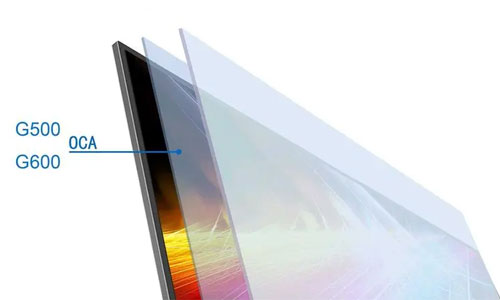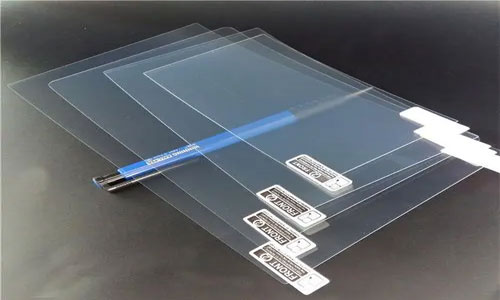OCA optical adhesive is a widely used material in the display industry for bonding and enhancing the visual clarity of screens. When it comes to precision cutting of OCA optical adhesive, the process involves accurately shaping it into desired sizes and shapes. This custom-cutting technique ensures that the OCA film perfectly fits the display area, maintaining the optimal adhesive performance. High-precision OCA optical adhesive cutting enables seamless integration between the screen and touch panel, creating a smooth and visually appealing user experience.

At present, there are several common OCA product structures on the market, depending on the assembly design of the TP factory.
Structure 1: The TP factory of large brand mobile phones uses this structure more, and needs to change the film, which has higher requirements for materials and environment, and the cost will be higher.
Structure two: The same as structure one, all need to change the film, and have the same high requirements for the material and the environment, the difference is that the heavy release film does not need to be cut off and does not need to carry belts.
Structure 3: This structure is commonly used in the cottage mobile phone market, and it is cut from the heavy release film surface to the light release film surface, and half cut to the light release film. From the material point of view, there is no need to carry the belt and do not need to change the film required by the high purity light release film, material cost saving; From a quality point of view, not changing the film means that foreign bodies, dirt can be ignored, unless it is a poor material. In short, the cost of materials decreases and the yield of products increases.
OCA die-cutting requires that the edge of the outer frame must be straight, no burr, shrinkage, overflow, extrusion, and no bubbles in the middle.
There is a certain OCA optical adhesive die-cutting method, which includes the following steps: (1) Prepare OCA die-cutting materials and processing equipment; (2) OCA material slitting: place the OCA material in a dust-free room, divide the OCA material into strips, and wind the OCA material onto a 6-inch roll core; (3) Die-cutting: use a die-cutting machine to die-cut the OCA material using a mirror blade wood die, with a wood board thickness of 21-22mm and a cushioning foam density of 45 degrees and elasticity of 70%; (4) Waste removal: remove the waste adhesive from the OCA material; (5) Inspection: place the OCA material in a class 100 inspection booth with an illuminance of 1000Lux-2000Lux and a black background, and inspect the product from 45° and 75° at a distance of 20-35cm.
For Structure 1 and Structure 2, the processing environment has strict requirements for dust concentration. It is recommended to strictly follow the cleanroom management regulations for die-cutting. It is best to use a class 100 cleanroom for processing. For Structure 3, it can be boldly stated that a strictly dust-free workshop is not required. A regular workshop (preferably with an epoxy floor coating, regular floor cleaning, and maintaining a certain level of cleanliness and temperature/humidity) can be prepared, along with a purification workbench equipped with FFU (high-efficiency filter) for quality inspection and packaging. This type of workshop is suitable for die-cutting manufacturers in the counterfeit market with low investment.

Key control points for OCA die-cutting:
1. Die mold
2. Cushioning foam
3. Waste removal angle
4. Control of the pressure on the laminating drum
5. Requirements for the release film when changing films
OCA processing technology introduction (for reference only, may not be suitable for other die-cutting factories) - Circular blade process technical points:
1. Die mold structure
2. Process schematic diagram (using Structure 1 product as an example, for naked cutting scheme)
3. Strict requirements for the environment and materials in naked cutting.
Control of temperature and humidity to minimize static electricity generation. Static electricity is easily generated in dry environments.
Material control: Except for dust-free paper, other ordinary paper materials should not enter the dust-free room directly.
Friction of materials can also generate static electricity. If the material itself is dirty, contains foreign objects, or if debris and filaments generated during cutting and slitting are not removed before use, foreign objects may be present in the final product due to static electricity adhesion. Personnel control: Everything is caused by human factors. Failure to comply with management regulations can lead to the deterioration of the dust-free environment.
4. Naked cutting can achieve good results with regular indentation and shrinkage caused by the squeezing of adhesive around the product.
Flat blade process technical points:
The following is based on a wooden die board.
1. Lower template cushioning method: Use PC board.
2. Blade: 30° single-edge blade. Total blade height: 23.6mm; Board thickness: commonly used boards are 20mm, but it is better to use 21-22mm boards. Confirm if the blade edge is flat and sharp. If there are notches, it can cause edge bubbles and jagged defects, and the blade should be replaced. If the blade edge is inward or outward rolled, it can also cause edge bubbles and jagged defects. Use a 2000# sandpaper to uniformly grind the blade edge in one direction, with even pressure (requires some experience).
Cushioning foam:
Use a 35° high-resilience cushioning foam, protruding approximately 0.5mm above the blade. After installing the cushioning foam, it needs to be compressed with air at least 100 times to completely fill the entire blade cavity. The commonly used cushioning foam will have reduced elasticity after multiple die-cuttings, affecting the die-cutting quality.
Flat blade structure:
It is better to use a jump-cut design. Extend by 2-3mm on one side in the X direction and approximately 1mm on one side in the Y direction. If the mold is designed as a closed structure and directly cuts in one stroke, if the cushioning foam's elasticity is not good enough, it is most likely to cause indentation and more visible defects. In addition, for the closed structure, the interface between the wood board and the blade should be smooth. However, I always feel that the blade supplier's handling is not good enough. The jump-cut structure provides better results.
The above summary mainly addresses solutions to the problem of poor indentation around OCA products. Some die-cutting factories also tried using etching or engraving knives for OCA products but were not successful. The main reasons include blades not being sharp enough, single-edge blade effects not being achieved, and finding the right cushioning foam, among others. The common issues are adhesive shrinkage and significant indentation. During the R&D stage in 2007, it took a long time to overcome these issues, and eventually, the use of mirror blades was successful, so there was no further attempt to change the mold type. If the cleanliness conditions are excellent, flat blades can still be used for naked cutting. Whether it is an etching knife, engraving knife, or wooden die, beautiful products can be made.
Regarding waste removal, the biggest concern is adhesive re-sticking, where the product adhesive and waste adhesive stick together. During waste removal, they pull and tear each other, resulting in uneven cross-sections—a similar appearance to excess adhesive. Additionally, the waste removal angle should be carefully controlled. It is recommended to separate the waste of the release film from the waste of the adhesive. As for bubble problems, it is important to clearly understand where the bubbles occur, whether between the OCA adhesive and the heavy-release film or between the light-release film and the OCA adhesive. However, if a light-release film with appropriate release force is selected, the bubbles will disappear over time (of course, this also depends on the characteristics of the OCA adhesive).
Contact: Pamela
Phone: +86 189 6365 3253
E-mail: info@industryprocess.com
Whatsapp:+86 189 6365 3253
Add: Yajing Industrial Park, No. 59 Shuangjing Street, Weiting Town, Suzhou Industrial Park
We chat
